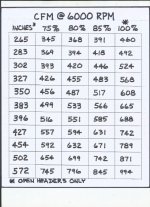Headers become very expensive ornaments when the restrictive mufflers get attached.
Just stopped by the Holley "Brands" Web Site, which includes, Accel, Hooker, Lakewood, Mr. Gasket, MSD, and more... up pops a small box in the lower right which is somewhat related to this thread, and maybe some members here might want to get in on it... may increase your horsepower, or not...
Hooker BlackHeart 2�15 Mustang Giveaway - Holley Blog
I have an 85 Vette, I just got it Feb 20th, 16, it was a beautiful Saturday. Due to unfortunate circumstances related to spinal health, I only drove the car once, from previous owners home to mine, approximately 1 hour, 15 mins. I've been watching this thread and looking up stuff for my Vette, having fun finding accessories and such for it... I'm incapacitated at the moment and won't be moving around too much for the next year... but I can dream and use PayPal...been doing some reading, mostly of magazines, and advertising materials of the time. I'm an 'ol timey electro-mechanical tech of many disciplines, and an amateur mechanic not afraid to try anything. Although those days are over. I've read a lot of articles and technical data about other cars. Even the 64 Comet with Inline 6, single barrel carb, I just sold was said to have improved horsepower with headers. They did Dyno tests. It was a magazine artical from 1967. These 3 prominent car guys wanted to see what kind of performance they could get out of the inline 6, while spending the least amount of time and money. It was very interesting.
Everything they did boosted the horsepower, performance, and driving economy, bit by bit. The headers they had to get fashioned. There was no promoting there, and they made a big difference. They added a 2 barrel carb, then I believe they may have added multiple carbs, then later on in Part 2, they added some wicked cool side-draft carbs. In 1967 you could get really cool junk in the junk yard, dirt cheap. They got huge performance gains, spent very little money (1967!), comparatively speaking, and the time spent was also minimal, but really, 3 guys, pros of the industry, and all their friend-pros, with all kinds of equipment... I think the average tech would have to spend more time on it than presumed.
After every modification they did Dyno Tests. I believe the Headers made a big, maybe the biggest improvement on the Dyno tests. They entered some bizarre race and I believe they came in first and got about 30 mpg to boot. I had that same inline 6 in my Comet. The Exhaust Manifold was a problem from day 1. That engine was the greatest 6 cylinder ever built. Those Pro Guys just ranted and raved about it. Just wave the key at it in any weather and she starts with 1/2 a crank and goes forever. But the exhaust manifold, for me, was bad. I found a set of inexpensive headers to try on. I never got the chance because I sold the car but I do believe they would have given my car several benefits.
There's a Web Site called ClassicInlines.com where there's a nice photo gallery of modified and stock inline 6's. Some of the Mods are simply Outrageous. The 1967 Article I mentioned is also summarized there. They also sell headers and carbs and heads and just about everything to improve the performance of your lil ol Ford 6 banger to make it competitive and kick butt with the V8 Big dogs.
I'd like to see some articles or maybe some bonafide test data that shows that just adding headers to your existing exhaust system doesn't make an improvement. Open pipes is almost surely the Best way to go for racing, but it would annoy people in civilian use. I think John Milner in American Graffiti took his exhaust junk off before racing Harrison Ford's '55 Chevy. I see that they even sell muffler eliminator kits for Vettes and you can listen to them on YouTube. I wonder if those Muffler Eliminators will increase horsepower, performance, economy. I'm going to ask The Google and see what I come up with. Maybe someone can start a new thread: "Did Adding Headers to your existing Exhaust System improve Performance", something like that, and then in your message ask those who have it, to post their Dyno Data. Get the truth from the man on the street, and/or track.







